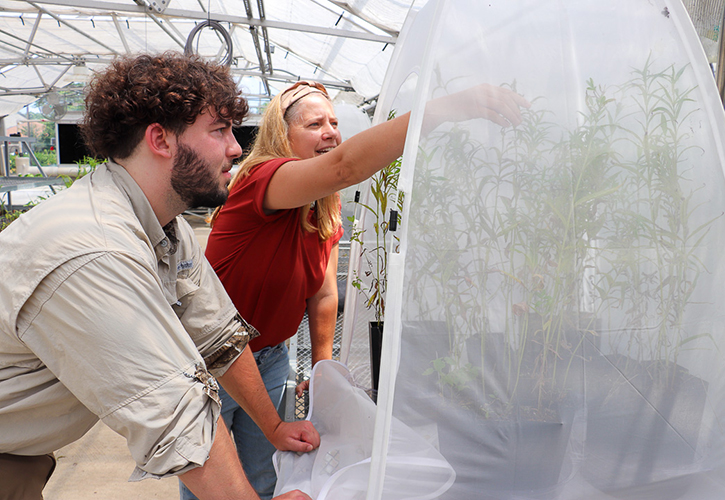College of Arts and Sciences Newsroom

UD biology student helps restore rare butterfly species in local wetlands
By Lauren McCarty ’26
University of Dayton senior Joseph Reichel helped restore a declining butterfly population in local wetlands through the College of Arts and Sciences Dean’s Summer Fellowship program.
Reichel, a biology major from Dayton, worked with Chelse Prather, associate professor of biology and coordinator of UD’s environmental biology program.
Reichel wanted to do a restoration project and connected with Prather through the Dean’s Summer Fellowship program, which allows undergraduate students to conduct summer research in any academic discipline under the guidance of a faculty mentor with funding through the College Dean’s Fund for Excellence.
Working with Five Rivers MetroParks, Reichel and Prather collected adult Baltimore Checkerspot butterflies and bred them to repopulate the species in the Spring Run Conservation area, a former golf course in Trotwood.
“I have been an ecologist for over 20 years but this is my first time working on a butterfly population,” Prather said. “Starting a new population of this rare butterfly would help to ensure the safety of this species in our area.”
Prather was approached by Grace Dietsch, a MetroParks biologist, to work on the project. Dietsch said land development has caused a decline in some insect species and the Baltimore Checkerspot butterfly has been difficult to repopulate in the Trotwood area, where the only known local population exists.
“Bringing the Checkerspot butterfly to Spring Run Conservation Area in Trotwood is a reintroduction of a rare species into a rare habitat,” Dietsch said. “The habitat requirements that are being established for the Checkerspot butterfly will also benefit a host of other wildlife species as well.”
Reichel has been interested in biology since high school. “I always thought bugs were kind of cool. I took a zoology course and it clicked for me that it’s what I wanted to do,” he said.
Reichel said the first step of the project was catching adult Checkerspot butterflies at Siebenthaler Fen, where there already is an established population.
“My favorite part was collecting them with a butterfly net,” Reichel said. “I did it as a kid, but to still be chasing butterflies 20 years later is pretty cool.”
The adult butterflies laid eggs in captivity, and Reichel and Prather studied the caterpillars as they hatched in greenhouse cages. They cared for the caterpillars in enclosures, which included frass cleanup, removing predators, watering fresh plants and replacing defoliated plants.
Prather said this particular butterfly species is under-researched, presenting many challenges to the project. For example, during summer the caterpillars stopped eating and all activity.
“It was really weird, we did lots to encourage them to eat, and it was hard because very little is known about the species,” Prather said.

Puzzled, she reached out to a colleague at another university for information about the species. It turned out that this was just part of the Baltimore Checkerspot’s life cycle.
“It’s completely normal, they eat for a few weeks and then they go into something called a semi-diapause, which is when they shut down activity,” Prather said. “It just wasn’t in the literature.”
After more than a year of being raised in greenhouses at Cox Arboretum, the caterpillars have reached adulthood as butterflies and are soon to be released at Spring Run.
“We hope that the individuals that we release will reproduce and start a self-sustaining population.” Prather said.
Though full restoration of the species in this area may take a number of years, this project should make the rearing process smoother in the future because of Prather and Reichel’s research.
“These butterflies are an important species and the wetlands are very important ecologically.“ Reichel said.
When he’s not doing field research, Reichel works in the UD Department of Biology’s intro-lab, caring for the turtles, axolotls, fish and other animals that live in the lab. He hopes to pursue a career in research and environment restoration after graduation.
Prather said her favorite part of teaching is to take students out into the field to show them scientific processes outside the classroom.
“Our department has these close ties with the MetroParks that are resulting in these projects that actually make a difference in terms of conservation and that is really cool,” Prather said. “Students learn real research skills on questions that are ecologically important to our local community which can be extremely rewarding for all those involved.”
Dietsch said Five Rivers deeply values its partnership with the University of Dayton.
"Projects like the Baltimore Checkerspot reintroduction would not be possible without the knowledge and guidance of Dr. Prather and her students," Dietsch said. "For UD, these parks serve as land labs for students and professors to practice their science. These experiences can help prepare them in their future careers."
For more information, visit the Dean’s Summer Fellowship and UD Department of Biology websites.

